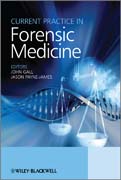
INDICE: Preface. Chapter One: Expert evidence and healthcare professionals.Introduction. The adversarial system of justice. Expert reports. Evidentiary exclusionary rules. Pre-trial preparation for expert witnesses. Appearance. Timeliness. Giving of evidence. Managing cross-examination. Summary. References.Chapter Two: Forensic investigation of biological weapon use. Introduction. Achoice of words. Threat assessments. Presenting features. Forensic microbiology or microbial forensics? Assembling evidence from emerging infectious disease biology. Current constraints. References. Chapter Three: The paediatric hymen. Introduction. Studies of normal anatomy. Studies of genital findings in sexually abused girls. Studies of acute injuries as they heal. A consideration oftest reliability. Putting it all together. References. Chapter Four: Assessment and interpretation of bone trauma in children. Introduction. How should I evaluate suspected bone trauma in children? What radiological investigations identify bone trauma? How do X-rays detect fractures? How does ultrasound detectbone injury? How do nuclear medicine scans detect bone injury? How does MRI detect bone injury? How are medical images presented and shared? What forces cause bones to fracture? Are some bone injuries diagnostic of child abuse? What do we know about bone healing in children? What tests detect fragile bones? Neonates with fractures: what are the special considerations? Can the time of bone injury be determined? Why might an X-ray be reported as normal when bone trauma exists? Why might an ultrasound appear normal when bone trauma exists? Why might a nuclear medicine scan appear normal when bone trauma exists? Why might an X-ray appear abnormal when no bone trauma exists? Why might a nuclear medicine scan appear abnormal when no bone trauma exists? How do I deal with correctly interpreted but discordant imaging findings? Why might an X-ray appear normal and bone scan hot when bone trauma exists? Why might a fracture seem obvious on plain X-ray but bone scan is 'cold' when bone trauma exists? When andwhy should I repeat x-rays? How does the process of forming a forensic medical opinion differ from the process of diagnosis in clinical medicine? Why do I need to be aware of my level of confidence in my medical diagnosis? What factors should I consider when forming a diagnostic opinion about the cause of a childs fracture? References. Chapter Five: Adult sexual assault. Introduction. Sexual assault settings and characteristics. Findings after sexual assault. Toxicology and sexual assault. Forensic science and sexual assault. Treatment after sexual assault. Summary. References. Chapter Six: The ethical and medical aspects of photo-documenting genital injury. Introduction. Sexual assault. Imaging the body in the history of medicine. Photography. The e
- ISBN: 978-0-470-74487-1
- Editorial: John Wiley & Sons
- Encuadernacion: Cartoné
- Páginas: 352
- Fecha Publicación: 04/02/2011
- Nº Volúmenes: 1
- Idioma: Inglés
